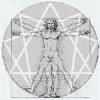B674 <=> B676 (BTG XXXVII France, p. 675)
“There in front of me, that stout contemporary gentleman with the enormous foreign growth on his neck is sitting with two young street girls . . . dress him in the costume of a ‘Kafirian,’ will he not be exactly like that very type I saw then sitting in a Kaltaan of the city Koorkalai?
“Or over there, on the left, at another table a contemporary young man is sitting, who in a squeaky voice convincingly holds forth to his bottle-companion about the causes of disorders which proceed in some community . . . dress his head in a ‘chambardakh’ and would he not be exactly like a real, as they were then called, ‘Klian-of-the-mountains’?
“And that tall man pretending to be an important gentleman, sitting alone in the corner, making eyes at a lady who sits with her husband among the neighboring company . . . is he not a real ‘Veroonk’?
“And these waiters, exactly like dogs with their tails between their legs, who serve the people sitting there . . . are they not ‘Asklay-slaves’?
“And in their majestic city Babylon, where I also happened to be, many of their centuries later . . . was it not the same there? Were not the three-brained beings of the city Babylon those same Asklays, Kafirians, Veroonks, Klians, and so on? . . .
“Only their dress and the names of their nationalities have changed.
“During Babylonian times they were called ‘Assyrians,’ ‘Persians,’ ‘Sikitians,’ ‘Aravians,’ and by other different names ending in ‘ian.’
“Yes . . . and now again, after so many centuries, I am again here, in their contemporary center-of-culture, the city Paris.
“And again it is the same . . . shoutings, uproar, laughter, scoldings . . . the same as in the city Babylon, as in the city Koorkalai, or even in Samlios, their first center-of-culture. . .

